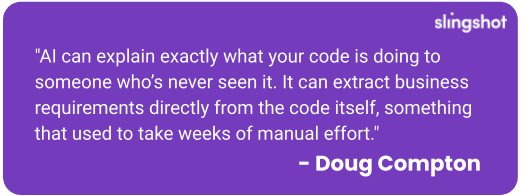Legacy systems often feel like a paradox: they run the business, yet they also slow it down.
As business leaders grapple with performance gaps, mounting tech debt, and the pressure to stay competitive, the word “modernize” often evokes anxiety. That’s because modernizing is usually synonymous with starting from scratch: an expensive, high-risk proposition with a fuzzy ROI.
But there’s another path. As Chris Howard, CIO at Slingshot, put it: “Legacy tech isn’t always broken. It’s just not delivering what it could if it had today’s capabilities.”
That’s where AI steps in. By embedding intelligence into existing systems, CIOs can reclaim performance, enhance functionality, and reduce operational costs without needing a complete rebuild.
At Slingshot, we’ve worked with companies facing this exact challenge: legacy systems that need to work smarter, not disappear. Below are five strategic ways to leverage AI for meaningful modernization, reforging legacy systems into agile, intelligent assets.
Summary
Legacy systems don’t need to be rebuilt from scratch to stay competitive. By applying AI strategically, CIOs can transform aging platforms into agile, intelligent systems that support growth rather than slow it down. From AI-powered code comprehension and ROI modeling to user behavior analysis and smart refactoring, modernization becomes faster, safer, and more aligned with business value. The key is knowing where AI can deliver measurable impact without disrupting what already works. Slingshot helps organizations unlock that potential, using AI to drive clarity, efficiency, and smarter decisions across their existing systems.
1. Shine a Light on the Unknown: AI for Code Comprehension
“Nobody really knows what it does,” said Doug Compton, a Principal Developer at Slingshot, echoing a pain point shared by many CTOs when describing legacy systems. Years of patches, shifting ownership, and undocumented changes create systems that feel opaque.
With AI-driven code analysis, those blind spots begin to disappear. Using large language models, you can parse source code and generate living documentation: what modules do, how they’re connected, and where hidden risks lie.
This intelligence becomes foundational. “AI can explain exactly what your code is doing to someone who’s never seen it,” said Doug Compton. “It can extract business requirements directly from the code itself, something that used to take weeks of manual effort.”

IT Directors can gain clarity and confidence. Decisions about enhancements, upgrades, or risk mitigation are no longer based on guesswork but grounded in insight.
2. Get Smart with Your Risks: ROI Modeling & Impact Simulations
Every modernization project must answer one question: Will this be worth it? That’s why you can’t stop at code analysis. You need to figure out the ROI of each recommended change.
Rachel Jennette gave a great example: “Imagine I’m a CIO whose business handles a lot of claims processing. If I hear we lost a pitch because we can’t upload documents digitally, I not only need that feature, but I need to know what it’s going to cost to add and what I get back.”
The real question becomes: would the value of that lost opportunity have outweighed the cost of implementation? That’s where AI-powered simulations shine. They yield tangible benefits, including reduced error rates, shorter development cycles, improved performance, and increased user satisfaction. Visual dashboards help leaders evaluate trade-offs. So they don’t just act; they invest with confidence.
Simulations turn decisions into strategy. CIOs can prioritize initiatives that deliver the highest business value, not just technical wins.
3. Supercharge Development Without Starting Over
Fears of disruption often hinder modernization, including breaking something that still works, sinking budgets into invisible improvements, or opening a Pandora’s box of tech debt.
AI defuses those risks. As Doug explained, “AI is very good at creating unit tests. If you have the unit tests done up front, you know that your code changes still perform the same as they did before.”
That concept, known as Test-Driven Development, was once considered nearly impossible due to the amount of upfront work required. With AI, it’s now practical. Developers can validate code changes early and often, reducing the risk of regression.
Beyond testing, AI also supports safer, smarter refactoring. Tools like Cursor and GitHub Copilot help developers navigate large and complex codebases, suggest improvements, and write more reliable code more quickly.
“AI tools can help reduce the cost of refactoring legacy code,” Doug added. “They don’t just write code faster, they help validate it, which lowers the risk of introducing errors during refactors.”
AI-generated test coverage and development assistance give teams the safety net they need. CTOs can green-light improvements with confidence, knowing their existing systems won’t be compromised.
4. Surface What Users Truly Need
Legacy systems age not only because of tech debt, but also because user needs evolve. AI helps teams stay aligned with those changing expectations by making sense of overwhelming feedback and data.
Instead of manually combing through session recordings, app logs, interviews, and forms, AI can rapidly synthesize all this information into clear, actionable insights. It helps teams identify common friction points, gaps in functionality, and opportunities for improvement without the need for weeks of analysis.
“We can map friction in user experience to underlying technical causes,” Chris explained. “That’s where exciting things start to happen.”
Technical business leaders can align tech enhancements with user needs. Modernization becomes a user-driven roadmap, not an IT-only initiative.
5. Preconditions for Success: What Makes AI-Driven Modernization Work
AI can accomplish a great deal, but it cannot operate in a vacuum. To unlock its full potential in modernizing established systems, several key elements must be in place.
“You need to have logging we can use,” Rachel Jennette said. “Or we need to set it up.” Without observability, AI has nothing to analyze.
Doug Compton added, “Things have to be testable.” If the system isn’t modular or lacks basic dependency injection, the value of AI-generated insights or unit tests is limited.
Documentation also matters, both in human-readable and machine-readable formats. Chris Howard emphasized the importance of consulting with stakeholders to understand what matters most, so the AI effort can be focused where it has the most significant impact.

These aren’t massive hurdles, but they are essential scaffolding. Logging, modular code, some architectural clarity, and openness to exposing the system to analysis are the preconditions that turn AI from a novelty into a catalyst for more innovative development.
CIOs don’t need perfect systems. However, with the proper groundwork, AI can deliver meaningful and measurable progress faster than ever.
What Comes Next?
Modernizing legacy systems doesn’t require burning them down. With the right AI tools, technical debt becomes manageable, enhancements become strategic, and decisions become data-backed.
The takeaway? You don’t need to rewrite your system to make it work smarter.
As Rachel put it: “You’re not modernizing for the sake of it. You’re modernizing because you’re trying to win a customer, avoid a lawsuit, or unlock efficiency.”
At Slingshot, that belief fuels everything we build. We’re helping CIOs maximize the value of their existing resources.
If you’re wondering how to get started, Slingshot can help. We can help uncover where AI makes the most impact, building alongside your existing infrastructure to ensure stability and clarity.

Written by: Savannah Cherry
Savannah is our one-woman marketing department. She posts, writes, and creates all things Slingshot. While she may not be making software for you, she does have a minor in Computer Information Systems. We’d call her the opposite of a procrastinator: she can’t rest until all her work is done. She loves playing her switch and meal-prepping.

Expert: Chris Howard
Chris has been in the technology space for over 20 years, including being Slingshot’s CIO since 2017. He specializes in lean UX design, technology leadership, and new tech with a focus on AI. He’s currently involved in several AI-focused projects within Slingshot.

Expert: Doug Compton
Born and raised in Louisville, Doug’s interest in technology started at 11 when he began writing computer games. What began as a hobby turned into his career. With broad interests that range anywhere from snorkeling, science, WWII history and real estate, Doug uses his “down time“ to create new technologies for mobile and web applications.

Expert: Rachel Jennette
Rachel is a certified PMP with 19 years of project management experience across industries like tech and supply chain. She loves turning big ideas into organized plans and believes great projects start with great people.




